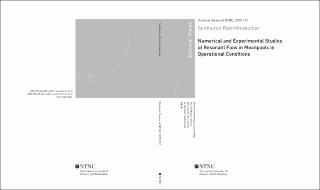| dc.description.abstract | The present work is relevant for ships with moonpools. A moonpool is a vertical opening through the ship hull, typically used to descend objects into the sea. Model tests and numerical simulations are carried out to investigate the hydrodynamic interaction between ship and moonpool responses. The studies are performed in forced motion and in freely floating conditions. We investigate ships with small, moderate, and large moonpools.
Four sets of model tests are carried out. In the first round, moonpools with recess are investigated in forced heave in a two-dimensional setting. The same set-up is investigated in freely floating conditions with incident waves in the second round. In the third round, moonpools without recess are investigated in both forced heave and freely floating conditions. The first three rounds of model tests are carried out in a wave flume at NTNU. These tests serve as a basis for the final and fourth round of experiments, which are carried out in the Ocean Basin at Sintef Ocean. The model tests in the Ocean Basin are the main part of the present work, where we investigate the hydrodynamic interaction between ship and moonpool responses in a three-dimensional setting. The experiments in the Ocean Basin are carried out with a ship model that resembles a real ship, with three different moonpool sizes. By that, we investigate the importance of the moonpool-to-ship-volumeratio on the hydrodynamic interaction between ship and moonpool responses, both in regular and irregular waves.
Two numerical solvers are implemented in the present thesis work; a two-dimensional time-domain boundary element method (BEM) code solving the linearized potential flow problem and a two-dimensional hybrid solver combining Navier–Stokes and potential flow solvers. These solvers are used to estimate the moonpool and ship responses, and the numerical simulations are compared against the model tests that are carried out in an idealized two-dimensional setting. WAMIT and an existing hybrid Navier–Stokes solver (PVC3D) are used to perform numerical simulations in 3D.
Based on the model tests and numerical simulations, we see that the moonpool and ship responses are strongly coupled for ships with moderate and large moonpools. For small moonpools, the hydrodynamic interaction between ship and moonpool responses is almost negligible. The importance of damping due to flow separation at the moonpool entrance is discussed, both at the piston and sloshing modes. Several nonlinear free-surface effects are discussed, such as Duffing-type moonpool responses, swirling and secondary resonance, where most of them occur in a relevant wave period range with respect to ocean waves in the North Sea. | en_US |
